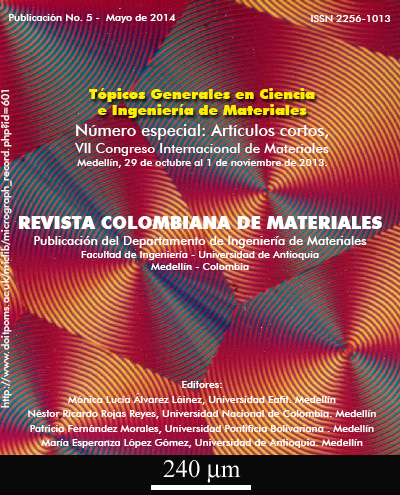.
DOI:
https://doi.org/10.17533/udea.rcm.19413Keywords:
Porosity, Thermal barrier coatinngs, Digital image analysisAbstract
Downloads
References
G. Evans, D. R. Mumm, J. W. Hutchinson, G. H. Meier, and F. S. Pettit, “Mechanisms controlling the durability of thermal barrier coatings,”
Progress in Materials Science,Vol. 46, No. 5, pp. 505–553, Jan. 2001. DOI: https://doi.org/10.1016/S0079-6425(00)00020-7
M. P. Boyce, Gas turbine engineering handbook. Access Online via Elsevier, 2012.
.H. J. Jang, D.-H. Park, Y.-G. Jung, J.-C. Jang, S.-C. Choi, and U. Paik, “Mechanical characterization and thermal behavior of HVOF-sprayed bond coat in thermal barrier coatings (TBCs),” Surface and Coatings Technology, Vol. 200, No. 14, pp. 4355–4362, 2006. DOI: https://doi.org/10.1016/j.surfcoat.2005.02.170
R. A. Miller, History of Thermal Barrier Coatings for Gas Turbine Engines. Glenn Research Center, Cleveland, OH, 2009.
N. P. Padture, M. Gell, and E. H. Jordan, “Thermal barrier coatings for gas-turbine engine applications,” Science, Vol. 296, No. 5566, pp. 280–284, 2002. DOI: https://doi.org/10.1126/science.1068609
Osorio Julián, Maya Deiby, Barrios Augusto C., Lopera Adrian, Jiménez Freddy, Meza Juan M., Hernández-Ortiz Juan P., Toro Alejandro, “Correlations between microstructure and mechanical properties of air plasma-sprayed thermal barrier coatings exposed to a high
temperature”; Journal of American Ceramic Society; Accepted Manuscript,2013.
X. C. Zhang, B. S. Xu, H. D. Wang, and Y. X. Wu, “Effects of oxide thickness, interlayer and interface asperity on residual stresses in thermal barrier coatings,” Materials & design, Vol. 27, No. 10, pp. 989–996, 2006. DOI: https://doi.org/10.1016/j.matdes.2005.02.008
W. R. Chen, R. Archer, X. Huang, and B. R. Marple, “TGO Growth and Crack Propagation in a Thermal Barrier Coating,” Journal of Thermal Spray Technology, Vol. 17, No. 5–6, pp. 858–864, 2008. DOI: https://doi.org/10.1007/s11666-008-9251-8
C. Funke, J. Mailand, B. Siebert, R. Vaben, and D. Stover, “Characterization of ZrO-7 wt.% YO thermal barrier coatings with different porosities and FEM analysis of stress redistribution during thermal cycling of TBCs,” Surface and Coatings Technology, Vol. 94–95, pp. 106–111, Oct. 1997. DOI: https://doi.org/10.1016/S0257-8972(97)00486-6
“ASTM international. Standard Guide for Metallographic Preparation of Thermal Sprayed Coatings, E 1920–03 (Reapproved 2008).”








